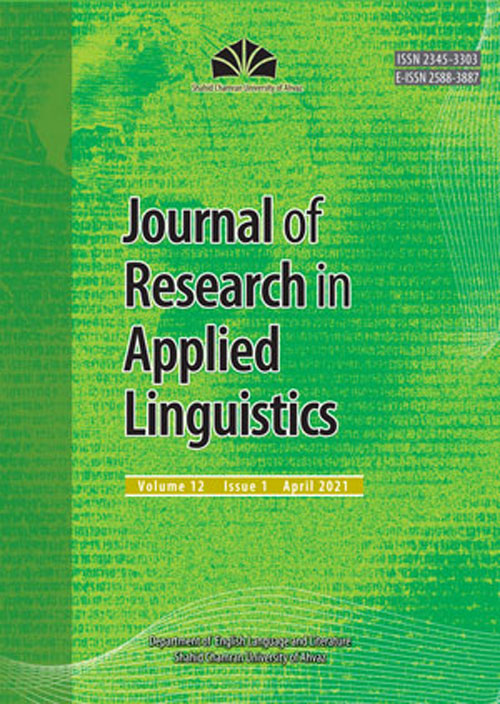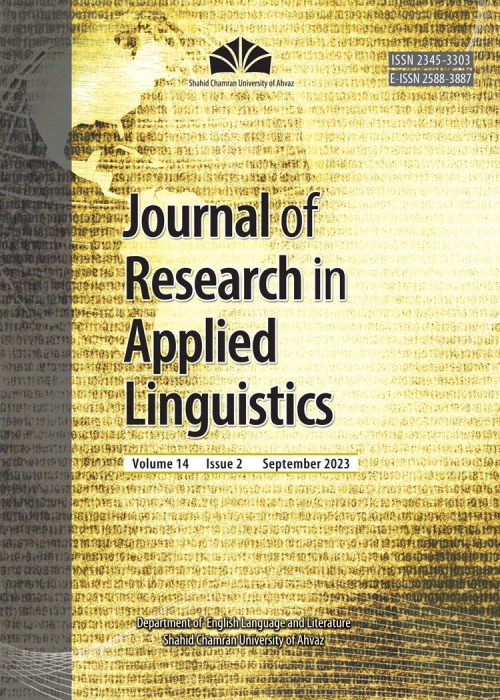فهرست مطالب

Journal of Research in Applied Linguistics
Volume:12 Issue: 1, Winter-Spring 2021
- تاریخ انتشار: 1400/01/22
- تعداد عناوین: 8
-
-
Pages 3-14
Most studies in optional functional element (OFE), specifically the optional function word (OFW) such as the optional that and obligatory contour principle (OCP),are concerned with accounting facilitation in language production in L1. The present study accounted for comprehension facilitation of OFE and OCP in syntactically ambiguous clausal complement, and OCP in L2 production among 180 ESL speakers. Utilizing quasi-experimental through the nonequivalent groups research design, the study found out differences in the interpretation of sentences with and without that. Adjacent identical elements (double thats) seemed to be avoided because they are perceived to be ungrammatical. Findings suggest that complementary clause (CC), with an embedded specific noun, is easily understood if optional that is included, whereas CC with an embedded common noun is easily understood without the said optional word. Findings are also pivotal in understanding comprehension-facilitation and production-facilitation accounts in L2 with respect to OFE and OCP.
Keywords: comprehension, Language Production, Identical Elements, Optional Functional Element, Obligatory Contour Principle, Psycholinguistics -
Pages 15-32Research on the effectiveness of request instruction in L2 pragmatics has been extensive, yet inconclusive. The present meta-analysis aims not only to provide a quantitative and reliable measure of the effects of instruction for the speech act of request in Iran, but also to illustrate a description of the relationship between some variables that moderate its effectiveness (age, gender, proficiency level, treatment type, research design, and data collection procedure). To do so, a total of 37 studies were retrieved and by establishing a set of different inclusion/exclusion criteria, 17 primary studies were coded and analyzed. Results revealed that (1) there is an overall large effect size on the effectiveness of the instruction of request (g = 1.48) in an Iranian context; (2) some variables were found to be a moderator for this effectiveness like gender and treatment type; (3) considering gender, the male group produced a larger effect size (g = 3.09) than the female one (g = 1.10); (4) and regarding treatment types, the explicit group yielded a larger effect size (g = 1.53) than the implicit one (g = 1.20). A thorough interpretation of the results, as well as a discussion of practical, theoretical, and methodological implications of this study, is provided to tackle a number of conundrums surrounding the instruction of request and shed light on how to reorient future research.Keywords: Instruction, Request, Second Language Pragmatics, Meta-Analysis
-
Pages 33-47
Given the undeniable significance of communication in language education, different models have been proposed to render communicative competence (CC) and its constructs. However, there seems to be an undisclosed construct which considers individuals’ real-world knowledge and sensory experiences essential in initiating and maintaining communication. To have an update on the existing models, this study introduces the emosensory account to the underlying competence of CC. Specifically, the study pursued to, first, develop and substantiate the emosensory competence (ESC) questionnaire and, then, to investigate the extent to which ESC predicts L2 speaking ability. To this end, 254 EFL learners filled out the ESC questionnaire in phase 1. In phase 2, the degree of ESC of 184 participants was analyzed in relation to their IELTS speaking scores. Results revealed that the ESC questionnaire enjoys psychometric properties and that, unlike socioemotional and sensory domains, cognitive topics are negative predictors of L2 speaking ability.
Keywords: Communicative Competence, Emosensory Competence, Emotioncy, Speaking Ability, Willingness to Communicate -
Pages 48-67
The current study sought to bring into light the important functions of pre and postmorbid nondominant language interventions and aphasia patients’ level of L1-L2 proficiency considering the productive dimension of vocabulary knowledge affected by intertrial tasks. Two Persian-English bilingual cases with anomia and different levels of postmorbid L2 proficiency were subjected to a treatment of English naming to find the contribution of English naming improvement to Persian naming. Both cases were given the therapeutic language intervention to enhance their naming performance of English lexical items and to find out whether it could be generalized to Persian equivalents.Data obtained from the 2 participants were analyzed using semantic naming tests, and the responses were validated through time-series analysis. Statistical findings suggested that participant 1, who had a higher L2 proficiency, exhibited higher performance than participant 2 throughout 5 consecutive trials, once they had received phonemic cues after semantic ones. Concerning within-language impacts, treated items exhibited a considerable improvement. The treated items and repeated untreated ones improved concerning cross-language impacts.
Keywords: Lexical Retrieval, L1-L2, Pre, Postmorbid Language Proficiency, Nondominant Language, Stroke-Induced Aphasia, Anomia -
Pages 68-80The aim of this qualitative study was to analyze the manifestation of conceptual metaphors in the new and old versions of Iranian EFL high school textbooks (Vision series). To this end, in the light of critical metaphor analysis (CMA) as the theoretical framework, 74 excerpts from the EFL textbooks taught in the Iranian high schools were analyzed in 3 stages: description, interpretation and explanation. In the description stage, all the metaphors existing in the excerpts were identified and analyzed descriptively with details to show their metaphoricity. In the interpretation stage, these metaphors were checked to clarify whether or not they were conceptual metaphors. The third explanation stage explicated how the authors of the textbooks had exposed the students and teachers to the Iranian government policymakers’ ideological discourses through conceptual metaphors. Analysis of the data in the 3 stages showed that reification and personification were the most prominent linguistic tools in the old and new versions of EFL textbooks, respectively. Also, the discourse of the old version of the EFL textbooks was mainly affected by modernism, whereas that of the new version was extremely influenced by postmodernism orientations. These results have a number of implications for researchers and those interested in teaching English as a foreign language. Findings of the present study can open new windows to Iranian EFL teachers to be aware of the contents that ought to be taught.Keywords: EFL Textbooks, Critical Metaphor Analysis (CMA), Conceptual Metaphor, Discourse
-
Pages 81-98
Refusals are utterances spoken to perform the action of refusing. This face-threatening act has a significant function in societal interaction. This pragmatic study investigated Iranian English learners’ (IELs) behavior in realizing refusals on the basis of a cross-cultural comparison of American native speakers (ANSs) and Iranian Persian speakers (IPSs) in terms of production performance. Data came from 40 ANSs, 40 IPSs, and 40 IELs, elicited from a DCT varied with contextual factors of power and distance. Data were analyzed in terms of frequency and content of semantic formulas. Results indicated that, although all the groups employed a similar range of refusal strategies in responding to the refusals elicited by different initiation acts, cross-cultural variation was evident in the frequency and content of semantic formulas. In some cases, the IPSs and the IELs refused similarly in Persian and English, but differently from the ANSs, suggesting pragmatic transfer in the Persian groups. These differences in Persian and English refusals may cause pragmatic failure when Persian speakers rely on their L1 culture-specific refusal strategies in interacting with English native speakers. Thus, the development of L2 students’ pragmatic knowledge should become one of the priorities of the educational system.
Keywords: Refusals, Speech Acts, Cross-Cultural Pragmatics, Pragmatic Transfer -
Pages 99-114
This study investigated the differential impacts of the structured input (SI) and output-based instruction (OI) taskson the improvement of the receptive and productive knowledge of request modifiers. Eighty-three EFL learners were randomly assigned to the SI, OI, and control groupsthrough a quasi-experimental research design. Over a 5-week course, the explicit metapragmatic instruction on the target structures was delivered to all the groups; however, whereas the SI group was exposed to the SI tasks, the OI group was engaged in the dialogue-reconstruction task. Results of ANCOVA and paired comparisons showed the effectiveness of both instructions on L2 pragmatic knowledge. Whereas the SI was more effective in fostering the receptive knowledge of the target structures, the OI better improved the productive knowledge. Moreover, the comprehension gains were not retained in the follow-up test, but the production gains appeared to be durable between the posttest and the follow-up test.
Keywords: L2 Pragmatics, Output-Based Instruction, Request Modifiers, Structured Input -
Pages 115-126
Having their own unique characteristics, interactions in everyday communications are categorized as culture-dependent and universal. Whereas politeness and impoliteness, in general, are universal characteristics of interactions, they are considered to be culture-sensitive and gender-based. Although in recent years there has been an increasing interest in impoliteness and gender, little attention has been paid to the relationship between them across cultures. Therefore, the current study set out to investigate different impoliteness strategies employed by Persian and American male and female characters of 2 popular comedy series. The Persian comedy was regarded as a facsimile of its American counterpart. Analysis of the series helped develop a comprehensive framework in relation to the functions of impoliteness strategies. Findings suggested that both Persian and American male and female characters used sarcasm as their key tool mostly to spoil and ridicule the hearer. Findings showed that American male and female characters do not speak completely differently; however, Persian male and female actors exploit sarcasm to circumvent the religious and cultural limitations.
Keywords: Impoliteness Strategies, Gender, Comedy Series, Modern Family, Haft Sang


